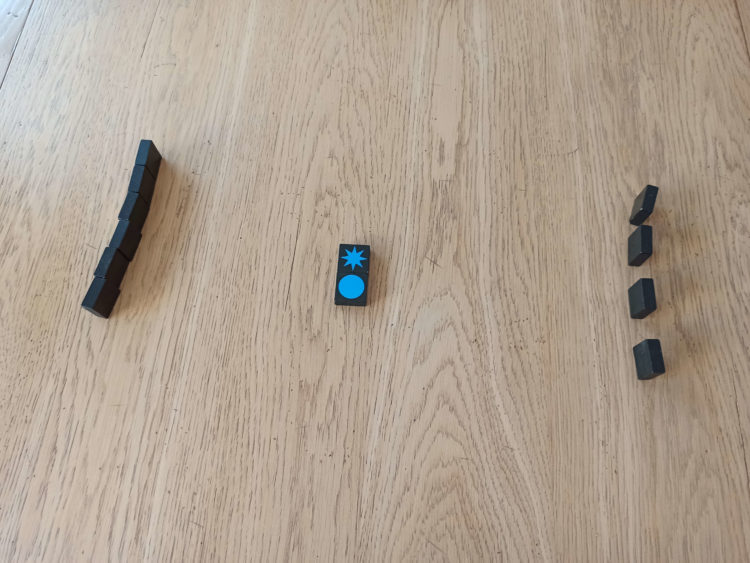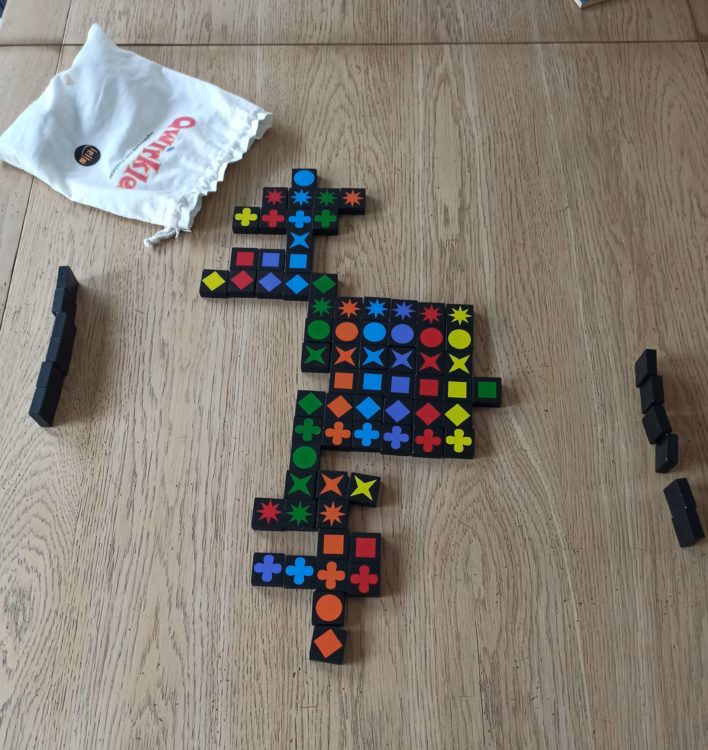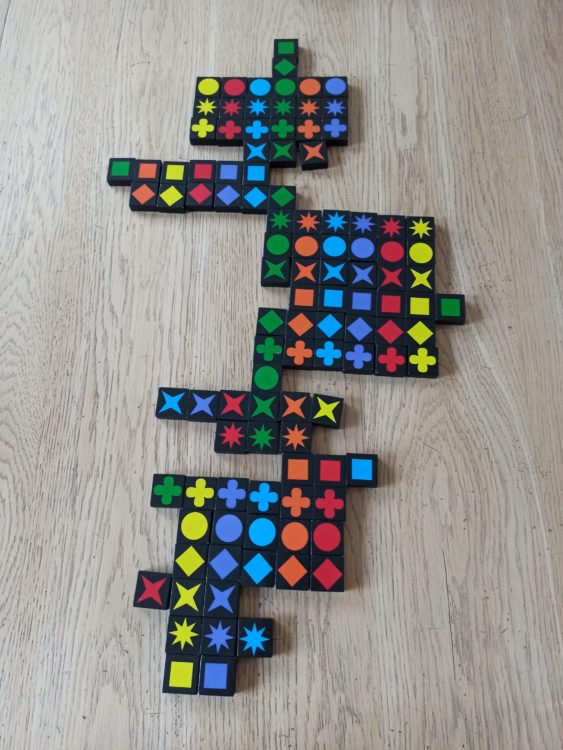
OBJECTIVE OF QWIRKLE: The objective of Qwirkle is to collect more points than other players by aligning tiles with colored symbols.
NUMBER OF PLAYERS: 2 to 6
MATERIALS: 108 tiles (3 times 36 different tiles: 6 shapes, 6 colors), 1 fabric bag
TYPE OF GAME: tile-placing game
AUDIENCE: children, teen, adult
OVERVIEW OF QWIRKLE
Somewhere between Scrabble, dominoes and Jungle Speed, Qwirkle consists of aligning tiles with symbols of identical shape or colour in order to create combinations that yield maximum points.
SETUP
- Take 1 sheet of paper and 1 pencil (to note the score).
- Place all tiles in the bag.
- Each player randomly draws 6 tiles from the bag.
- Players place their respective tiles in front of them so that no other player can see the symbols. These tiles form the player’s hand.
- The remaining tiles form the reserve and remain in the bag.
Determination of the first player
Each player examines his draw and announces the highest number of tiles with a common characteristic: colour or shape (attention: duplicate tiles are not included in this number).
The player with the highest number starts the game. In case of a tie, the oldest player starts.
This player places his tiles (with a common characteristic) on the table and scores his points. He then draws from the reserve to have 6 tiles in front of him again.

GAMEPLAY
In clockwise order, each player may perform one of these 2 actions:
- Complete a line by adding one or more tiles, then draw from the reserve to complete your hand with 6 tiles. All tiles played from the player’s hand must share a characteristic, namely colour or shape. The played tiles must always belong to the same line (they may not touch each other).
- Exchange all or part of the tiles in his hand for as many other tiles from the reserve and pass his turn (without playing a tile).
Complete a line
Players take turns adding tiles to complete the line created in the first round and its ramifications. The following rules apply:
- It is not possible to play tiles that are not connected to the existing lines.
- There are 6 shapes and 6 colours. Players create lines of shapes or colours.
- Two or more tiles touching each other create a line of shapes OR a line of colours: the tiles that are added to this line must have the same characteristic as the tiles already on the line.
- It may happen that there are places on the line where no tiles can be added because of tiles from other nearby lines.
- Single line rule: tiles added by a player must always belong to the same line, but can be placed at both ends of the completed line.
- Single tile rule: never twice the same tile in a row, and therefore never more than 6 tiles in a row (since there are 6 different colours and 6 different shapes).
Exchanging tiles
When your turn comes, you can choose to exchange all or part of your tiles instead of adding them to a row. In this case, you must:
- put aside the tiles to be exchanged
- draw the same number of tiles from the reserve
- mix the tiles that you had set aside in the reserve
- pass your turn
If you cannot add tiles to any line on the table, you MUST exchange all or part of your tiles and pass your turn.

Scoring
When you create a line in the first round or subsequently complete a line, you earn 1 point for each tile in that line. This includes all the tiles in the line, even those you have not played.
Special cases:
- A tile can score 2 points if it belongs to two different lines.
- Qwirkle: You score 6 extra points each time you complete a line of 6 tiles. A Qwirkle therefore earns you 12 points (the 6 points of the line + the 6 bonus points).
END OF GAME
When the supply is empty, players continue to play normally, but do not draw any more tiles at the end of their turn.
- When a player has played all his tiles, the game ends and that player gets 6 extra points.
- If no player can complete a line with their remaining tiles and the reserve is empty, the game stops immediately and the 6 bonus points are not awarded.
- The player with the most points wins the game.

Enjoy! 😊
TIPS
- Count the tiles: For example, if you are waiting for a yellow circle, check that they have not all been played (there are 3 yellow circles in the game).
- Multi-line: Try to play tiles that fit into several lines at once to score more points.
- Avoid creating lines of 5: Because you would give the opponent the opportunity to perform a Qwirkle.
- Comprehensive Guide to the Board Game Go (weiqi, baduk) - January 23, 2024
- Are Creative Suites Changing Gaming - October 30, 2023
- Crowning the Kings of Solitaire: GameRules Recognizes Solitaired and MobilityWare as top Solitaire Games - October 20, 2023